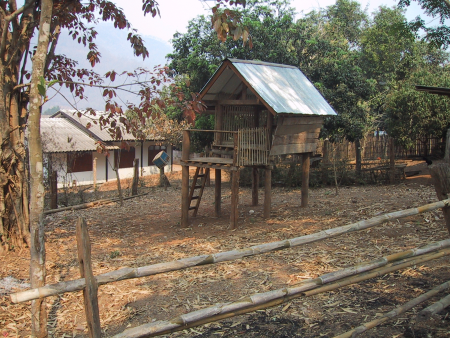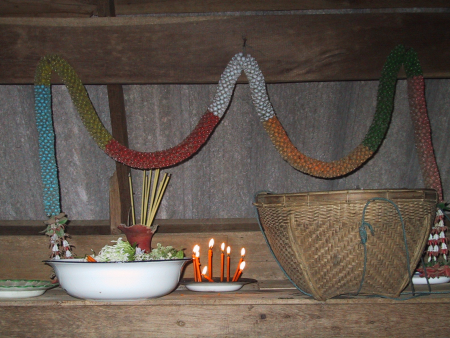It’s been longer than I hoped since the first post in my new “Anthroblog” series. I have been diverted by administrative tasks. But I’ve found some time to return to the task…
As I indicated in the first post, for the time being I am focussing on Baan Tiam’s history, and the various ways in which history is remembered and talked about in the present. In this post, I want to look at Baan Tiam’s origin narrative. It goes something like this:
Baan Tiam village was established by three people who came from Pasan Distict. They were pho (father) Naan Tan, pho Naan Puntip and pho Jinali. These three built the village’s first temple. In fact it was a very small hut, in which Buddha images were worshiped. The temple was located between the river and the mountains. These three founding settlers also built two spirit shrines. One was for the jao nai ton chok (the “lord of the lucky tree”) which was in the middle of the village and the other was for the suea baan (village spirit) which is on the eastern side of the village. These two shrines were built to protect the village from outside spirits so the villagers could live together in tranquillity.
These are sketchy historical details, but they highlight two important motifs that regularly occur in local discussion of Baan Tiam’s past.
First, the original settlers are said to have from from Pasan District (my pseudonym). This district is located about one day’s walk downstream from Baan Tiam. It is a rough walk, along the banks of the rocky river (and occasionally in the middle of it) that I recently re-enacted with a group of villagers and a hard-drinking National Parks officer. There is no road along the river, but in the past this was an important route for trade and passage in the region. A considerable number of men in Baan Tiam, especially older men, were born in Pasan District. They came to Baan Tiam as traders, timber workers, police officers on hardship postings, farmers in search in land, and as young men in search of wives. Baan Tiam’s “origin story” reflects the importance of this link with Pasan District (and others that lie along the river).
A second interesting motif is that the story emphasises the spiritual achievements of the men. Two of them have the title “naan” indicating that they had been ordained as Buddhist monks. In the origin story, their first major achievement was to establish a Buddhist temple, bringing the primary northern Thai symbol of culture and civilisation to the village. But they also attended to other important aspects of the cosmos. They built two shrines for the domestication of important local spirits. The suea baan is now housed in a small shrine on the upper, eastern, side of the village.
Despite the reference to it in the origin story, I suspect that it was established fairly recently, as the residential area of the village expanded up the slopes of the mountain, creating a hamlet that has an identity somewhat distinct to that of the original settlement clustered around the village temple. Alternatively, it could have been a forest shrine that has now been incorporated into the residential area of the village. It is an unremarkable structure. Offerings are made there on important ritual occasions, but it seems to have a rather peripheral role in village affairs.
The “palace” of the lord of the lucky tree is a considerably grander affair. This is located in the heart of the original settlement area within the village, close to the village temple. Many of the “origin houses” of the matrilineal lineages within the village are located in the vicinity of this shrine. As in many areas of northern Thailand, the occupant of this shrine is referred to as a “prince” or “lord” (jaw) rather than a “spirit” (phi). Elaborate offerings, to which all village households are expected to contribute, are made to him during the new year (songkran) festival.
Before his “palace” was constructed, the lord resided in the lucky tree, a large old tree which Baan Tiam’s villagers sometimes consult for lottery numbers (by scratching the bark until the oozing sap forms the shapes of numbers). One villager told me that the tree is a thousand years old. Another told me that it is the “lak muang” (city pillar) of the village, though another vigorously disputed this, arguing that only a muang (town or city) can have a lak muang. An elderly woman told me that the lord first made his protective presence felt when invading Burmese soldiers rested beneath the tree. The lord of the lucky tree made them fall into a deep sleep and they were then easily killed by villagers who were hiding nearby.
Baan Tiam’s brief origin narrative highlights important local perceptions about the nature of power. Local power and protection is emergeds out of a productive interaction between external forces (represented by the founding migrants with their Buddhist credentials) and more localised nodes of influence (represented by the forest spirits). By building palaces for the spirits, and by honouring them with feasts, the villagers elevate them to the status of lords and situate them within a region-wide hierarchical network of protective lords and princes. This productive interaction between different networks of power is the central theme I am exploring in my current writing on Baan Tiam.
 Facebook
Facebook  Twitter
Twitter  Soundcloud
Soundcloud  Youtube
Youtube  Rss
Rss 

